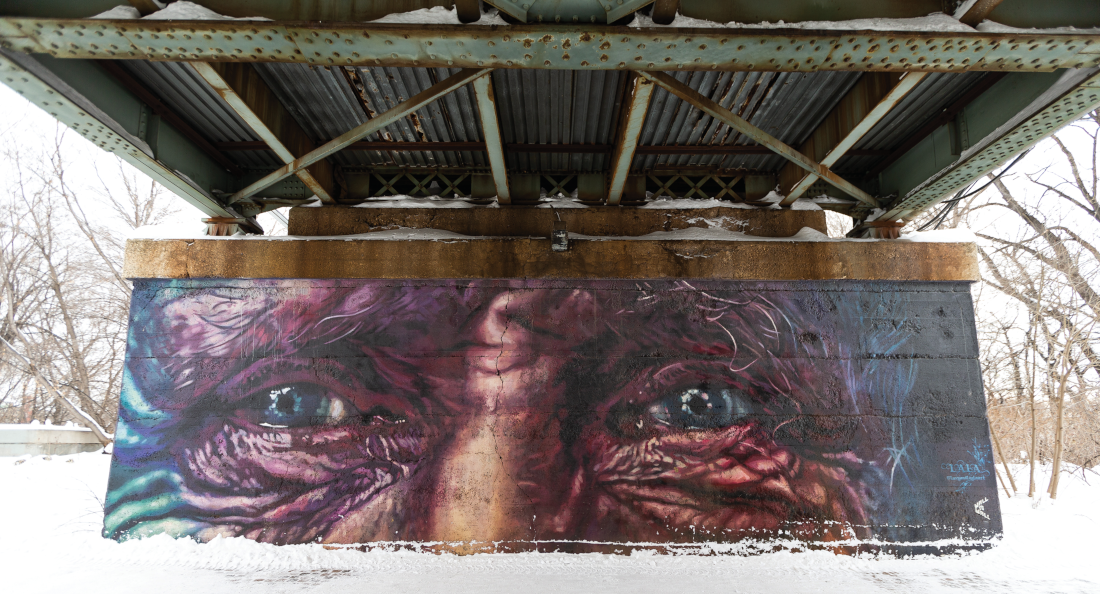Who owns the streets?
Public art does and should reflect the community
Winnipeg – particularly in the urban areas – is rife with street art, from stickers to murals and beyond. Passersby may notice reclaimed household items, painted and emblazoned with a simple message: press on. Posters are modified with robot heads, and the lost character from Where’s Waldo can be found repeatedly in different iterations.
More and more street art seems to have appeared in the past decade. Who’s behind it?
Public space
Winnipeg Waldo is a street-art take on the character hidden in the pages of the popular series of children’s puzzle books.
According to the artist behind Winnipeg Waldo, there is a sense of public ownership over public space.
“It’s a space that we all sort of occupy. We all have some sort of claim over (it), because we’re the ones who are walking around and seeing it every day. It’s artwork directly interacting with people.”
Recognizable to most is the Jerry Pizzaman character, the angry-looking slice eating itself. The artists behind these pieces go by the name Toxic and describe their work as “part guerilla and part utilitarian.”
“Instead of waiting for a gallery or museum or whatever to show our art, we can just put it up,” one of the artists behind Toxic says in an emailed statement to The Uniter.
The artists admit that it is a lot of work, especially as “90 per cent of it gets torn down in the next couple days,” but they enjoy the idea of putting art where it isn’t supposed to be.
“It makes it a little more interesting and exciting for people to discover. To see it over and over again and think to themselves ‘What is this? Is it supposed to mean something?’”
The Pallet Pillar is a collaborative art installation between street artists Winnipeg Waldo, Press On Winnipeg and Toxic, located across from Shaw Park near The Forks.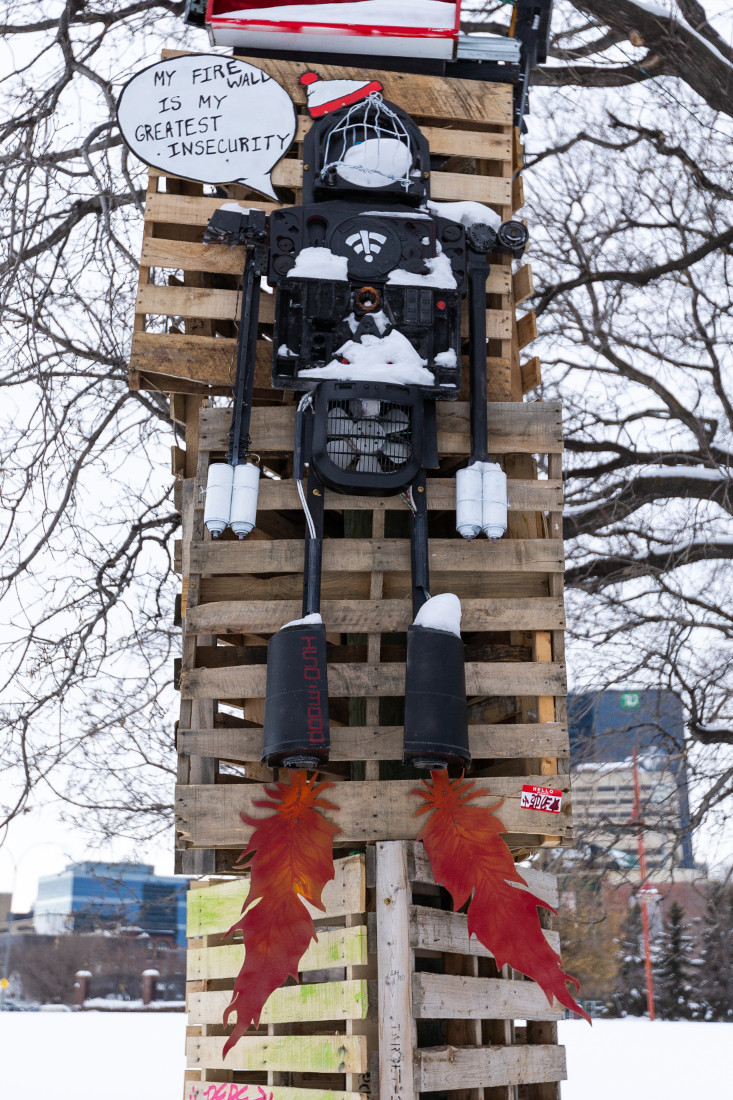
A hidden world
The artist behind Winnipeg Waldo says their favourite part of street art in any given city is following specific artists or characters.
“It’s almost kind of like you’re collecting them, right? It’s like its own little scavenger hunt.”
Usually accompanied by a bird, the message press on is painted on reclaimed materials and posted around the city, whispering a subtle message of hope and perseverance. The artists behind Press On Winnipeg talk about the importance of street art in an emailed statement to The Uniter.
“Grassroots-level street art can challenge the status quo. It can challenge the unhealthy systems of our society, inspire others to create. (It) brings a mysterious ‘hidden’ world to discover, forms a sense of community and can simply bring a smile to someone who is having a bad day.”
Whether it be stickers, posters, cardboard cutouts or large sculptures, there’s a way to get messages out there.
The artist behind Winnipeg Waldo describes the challenging process in getting the large-sized Waldo out onto the Perimeter billboard: a really tall ladder, lots of cardboard and a drill.
“The nice thing about cardboard was that I was able to fold it up without destroying it,” they say.
Street art “is artwork directly interacting with people.” - Winnipeg Waldo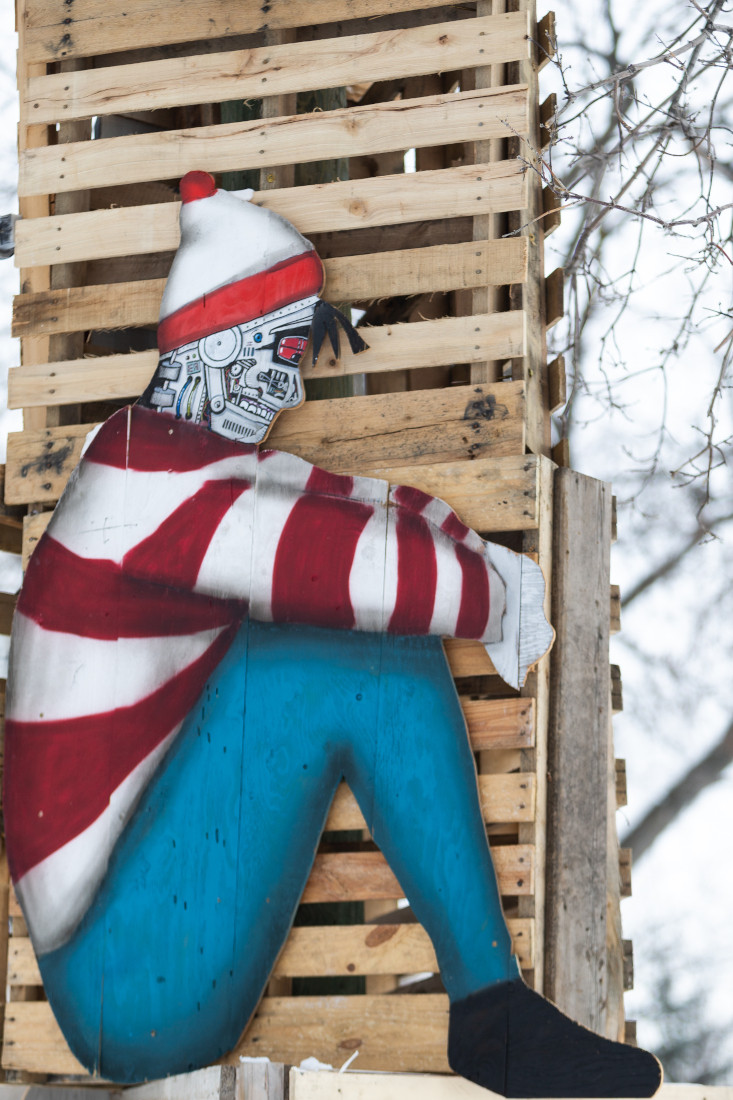
Press On Winnipeg uses reclaimed materials for a variety of reasons.
“1. It makes art far more affordable.
2. We see it as a positive direction when using art to clean up the earth.
3. There is a beauty in taking someone’s trash tossed on the ground and making it into something new for people to enjoy.
4. It adds a bit of randomness to our city (who wouldn’t want to walk around the corner and find a frying pan on a telephone pole?).
5. ‘Almost anything can be a canvas’ is a personal challenge for us,” they say.
The Winnipeg Waldo project began in 2017 after the artist visited cities overseas where street art was embraced – and not just sanctioned art, but grassroots-level art, as well.
“It was something that I was like, man, Winnipeg is really missing that sort of thing, that kind of folk street art that’s made by the people who kind of occupy the space,” they say. “I wanted to start a cool idea that I would have wanted to see walking around the city.”
While Winnipeg Waldo is kept local, Toxic strives to spread their art nationwide by putting up art when they travel and by giving stickers to fans and friends so they may do the same.
“In an ideal world, I’d have a Toxic robot on every street in every city,” they say.
“Grassroots-level street art can challenge the status quo.” - Press On Winnipeg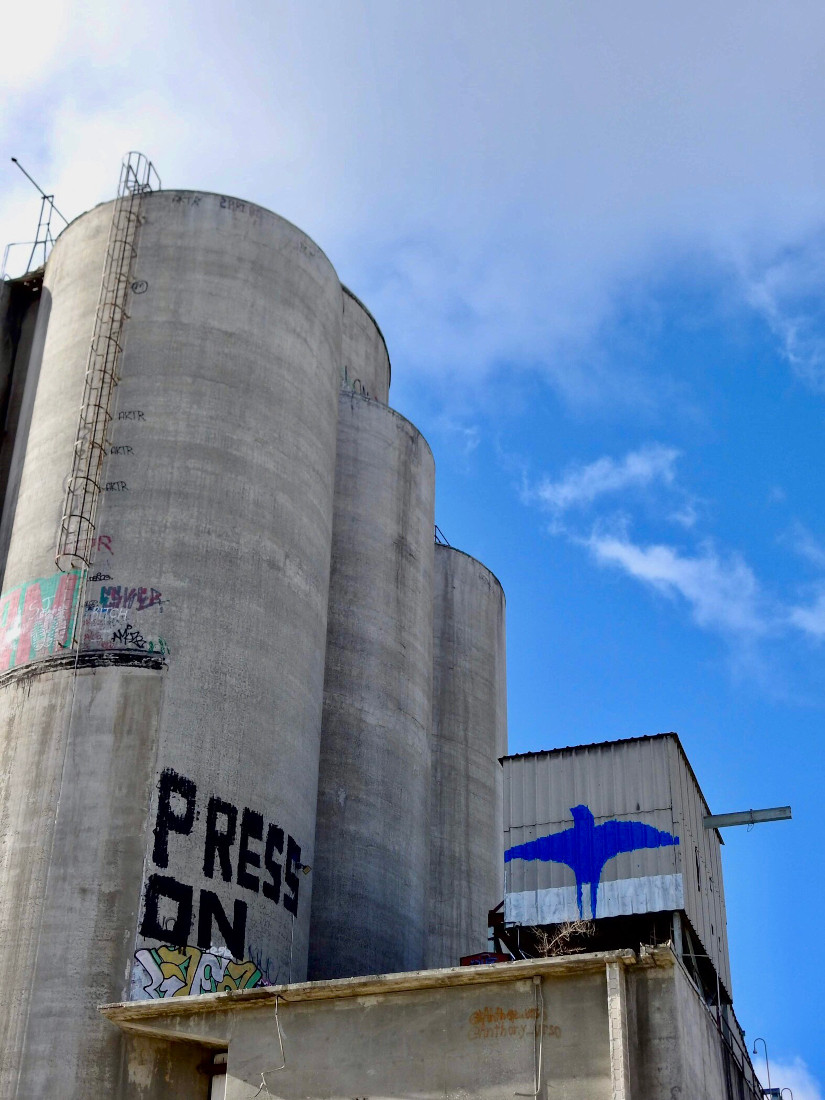
Representing community
“The city and community is generally welcoming to street art and graffiti, and ... it’s not generally super-frowned upon or prosecuted,” the artists behind Toxic say, adding that law enforcement doesn’t seem focused on penalizing street artists.
“It’s cool that we have more freedom to express ourselves in this medium in our country and community if we want to.”
“Street art really allows for turning our streets into contemporary public-art galleries that are accessible to (the) public at large and as many people as possible at all times,” Andrew Eastman, co-founder and co-creator of Wall-to-Wall Mural & Culture Festival and Synonym Art Consultation, says. “We want people who are walking our streets to have the opportunity to engage in discourse around public art and feel connected to works of art.”
Eastman says Synonym Art Consultation strives to highlight artists who are underrepresented in the community, helping them to get their work out there and develop their careers.
“We’re really also founded on an idea of trying to get opportunities for artists who sometimes exist outside of the more institutional (structure) – be that schoolof-art structure or art-gallery structure,” he says.
The mural-planning process at Synonym Art Consultation varies depending on the project. “Sometimes that will be a sort of youth-led initiative on the design of some murals. We will often work with Indigenous elders, (and) almost all of our projects are collaborations with local community organizations,” Eastman says.
He lists Graffiti Art Programming, Sunshine House, North End Community Renewal Corporation and Spence Neighbourhood Association as partners.
Eastman says Synonym Art Consultation strives to create work that not only reflects the community but also acts as “visual identity markers for the community.”
“Street art really has this ability to centre the artist themselves while also taking into account the community and its needs and dreams and desires,” Eastman says.
There are some barriers to creating sanctioned street art, however. Getting a project with a company can be highly competitive, the artists behind Toxic say.
“It still shuts out a lot of artists, only giving funding and exposure to the ‘winners.’ With street art, you don’t need permission. You don’t need a committee to deem that your art is worth seeing or that what you’re saying deserves to be heard. You just go out and show it to the world on your own terms.”
The artists add that grassroots-level street art can be democratizing, giving artists a chance to showcase their art without the confines of a gallery.
“That being said, street art also kind of isn’t important ... and that’s the point,” they add. “A lot of street art and graffiti sucks, but it’s cool that anybody can go out there and scribble on a wall. It doesn’t need to be profound or important or even good.”
“It seems like every month there is a new piece of art on a building around Winnipeg, and it is a beautiful thing,” the artists behind Press On Winnipeg say.
“We simply think both avenues of art bring happiness and beauty to the city, one form being generally larger in scale and more official and the other generally being smaller in scale and less official.”
Works of street art by local collective Press On Winnipeg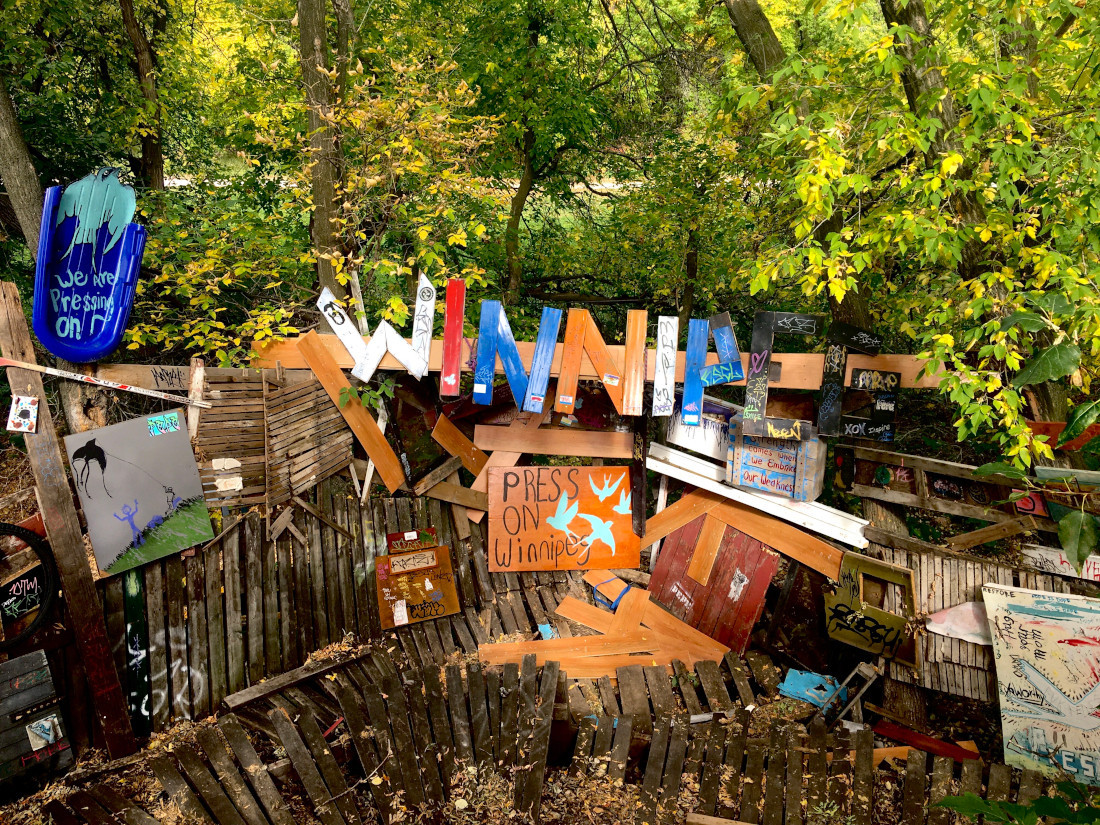
A flourishing decade
Synonym Art Consultation has been in operation for nearly a decade.
“We’ve just strived from the beginning to try and make art more accessible to the public and try and bring art into people’s everyday lives,” Eastman says, adding that Synonym does performance art, public events, concerts, music and mentorship, as well as public art and street art.
The artist behind Winnipeg Waldo says they have noticed more street art around the city in the past five to 10 years.
“The Wall to Wall mural festival has done a lot for street art in the city. I mean, it’s still sanctioned. It’s still not quite that sort of grassroots-level street art, but it’s still more of sort of a modern direction and kind of in touch with maybe those cities around the world that more embrace street art as an asset in the city.”
Press On Winnipeg has been around for about as long. It “started just over 10 years ago at the top of the Waterfront (CN) bridge.”
“The spirit behind press on was to bring a little hope and happiness to those who may stumble on it. We would maybe do one or two big or small projects throughout the years.” When the COVID-19 pandemic hit, the group decided to do more. “At the time COVID hit, everything was uncertain, and we thought (the) message press on was something that we should throw out on the streets in a larger capacity than we had before to bring something positive and hopeful in a time that was challenging, to say the least.”
Works of street art by local collective Press On Winnipeg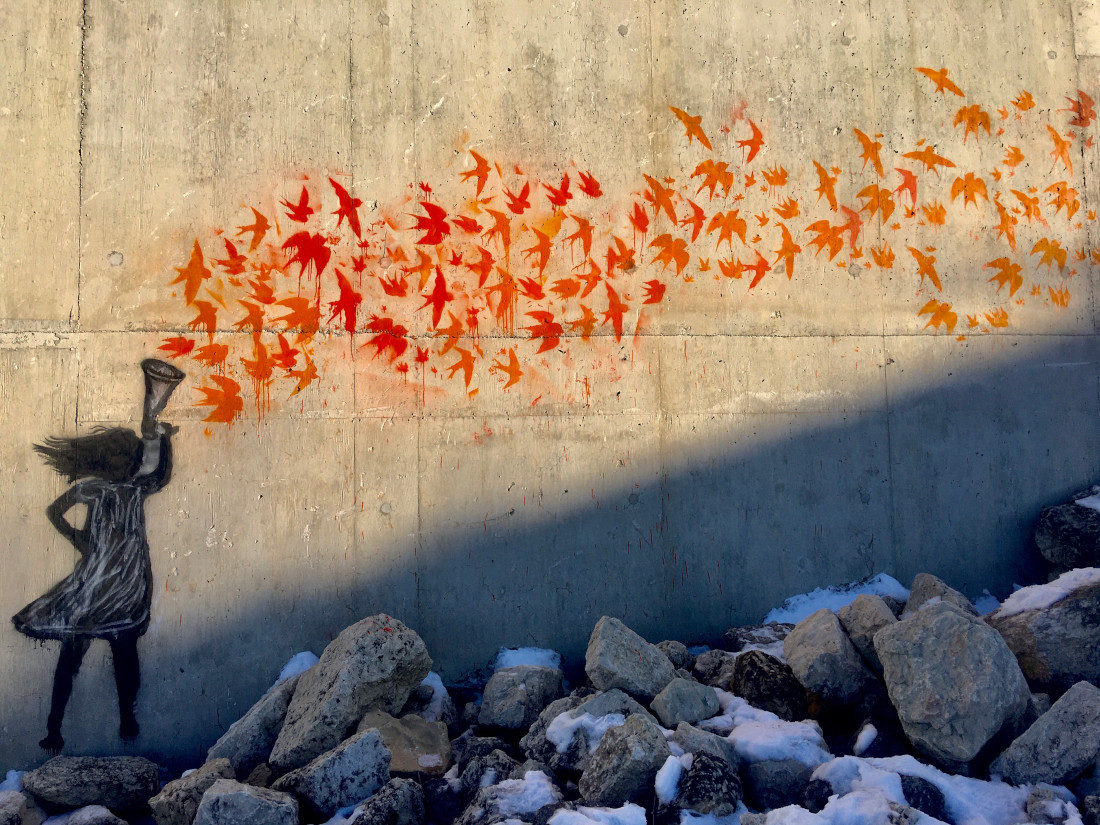
Collaboration > Competition
Press On Winnipeg, Toxic and Winnipeg Waldo recently collaborated on a large sculpture, a pillar created with pallets. The theme of the piece is “isolation,” according to Press On Winnipeg.
“We named our robot sculpture Iso3000. Originally on the chest of our sculpture was a caged heart, but later on in the process of creating the sculpture, the idea of a no-wifi sign made more sense for the piece. This COVID era that we live in has rapidly grown our connection to one another via social media/internet (for better or worse), and a no-wifi signal seemed fitting as a symbol portraying isolation in our present time.”
Toxic says the idea behind the collaborative piece is “to have some nice public art for people to look at and one that can be (a) collaboration with anybody in the city,” especially given the constraints of lockdowns.
“The biggest message that we (the Press On crew, Toxic, Waldo) want to get out to the public about this pallet-pillar collaboration is for everyone to add art to it (whether it is an art piece about isolation or not),” the team behind Press On Winnipeg say.
“We find great joy in creating art spaces for people to enjoy but also to join and add their own beauty to these spaces. Collaboration > Competition.”
Supporting street artists can mean collaborating on public pieces or buying merch when available, but Toxic says just being a fan means a lot, too.
“Messages, sharing art on social (media) and even just following and interacting with us (online or off) is a huge help. It’s partly just that our egos need the fuel of adoration, but it’s also inspiring when you see that people are enjoying and connecting with your art.”
Follow these street artists on Instagram at @winnipegwaldo, @press.on.wpg and @exclamationt.
Published in Volume 76, Number 13 of The Uniter (January 13, 2022)

